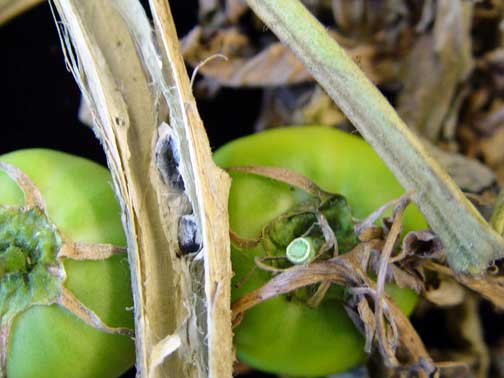Tomatoes With Sclerotinia Stem Rot - How To Treat Tomato Timber Rot


It's no wonder that tomatoes are the favorite plant of the American vegetable gardener; their sweet, juicy fruits appear in a huge range of colors, sizes, and shapes with flavor profiles to please nearly everyone's palate. Tomatoes are also hugely popular with fungus, including those responsible for tomato timber rot.
What is Timber Rot?
Tomato timber rot, also known as sclerotinia stem rot, is a fungal disease caused by the organism known as Sclerotinia sclerotiorum. It appears sporadically around the time tomatoes start to flower due to the favorable conditions that heavy tomato foliage cover creates. Timber rot of tomatoes is encouraged by prolonged periods of cool, wet conditions caused by rain, dew, or sprinklers and the high humidity that builds between the ground and the lowest tomato leaves. Tomatoes with sclerotinia stem rot develop water-soaked areas near the main stem base, at lower branch crotches, or in areas where there have been serious injuries, allowing the fungus access to internal tissues. The fungal growth that begins in these areas progresses outward, girdling tissues and developing white, fuzzy mycelium as it grows. Black, pea-like structures about ¼-inch (6 mm.) long may appear along infected sections of stems, inside and out.
Control of Sclerotinia
Timber rot of tomatoes is a serious, difficult-to-control problem in the home garden. Since the disease-causing organisms can live in the soil for up to 10 years, breaking the lifecycle of the fungus is the aim of most control efforts. Tomatoes with sclerotinia stem rot should be promptly removed from the garden-- their death is inevitable, and pulling them at the first signs of infection can protect unaffected plants. You should aim at controlling the conditions that allow this fungus to germinate, amending your tomato bed as needed to increase drainage and watering only when the top 2 inches (5 cm.) of soil are completely dry. Spacing tomatoes further apart and training them on trellises or tomato cages may also help since dense plantings tend to hold in more humidity. The spread of sclerotinia during the growing season may be halted by removing affected plants along with the soil in an 8-inch (20 cm.) radius around each one, to a depth of about 6 inches (15 cm.). Bury the soil deeply in an area where non-susceptible plants are growing. Adding a plastic mulch barrier to the remaining plants can also prevent the spread of spores originating from the soil. At the end of each season, make sure to remove spent plants promptly and completely remove any leaf debris before plowing your garden. Do not add spent plants or plant parts to compost piles; instead, burn or double-bag your debris in plastic for disposal. Applying the commercial biocontrol fungus Coniothyrium minitans to the soil during your fall clean-up can destroy many of the infectious sclerotia before planting in the spring.
Gardening tips, videos, info and more delivered right to your inbox!
Sign up for the Gardening Know How newsletter today and receive a free copy of our e-book "How to Grow Delicious Tomatoes".

Kristi Waterworth was a regular contributor to Gardening Know How for many years, answering countless queries on plant pests and diseases.
-
 12 Lush Alternatives To A Lawn For Sustainable Spaces
12 Lush Alternatives To A Lawn For Sustainable SpacesAlternatives to a lawn are beautiful and also beneficial to your local ecosystem and its pollinators. Explore our top picks for plants to replace grass.
By Tonya Barnett
-
 Types Of Tomatoes Explained: Explore The Many Wonderful Shapes, Colors, Flavors, & Best Uses
Types Of Tomatoes Explained: Explore The Many Wonderful Shapes, Colors, Flavors, & Best UsesThe world of tomato varieties is vast and fascinating. Learn about the key types to grow in your garden, tailored to your preferences and space.
By Amy Grant